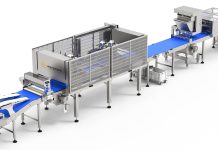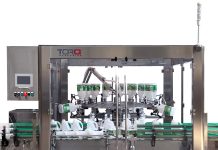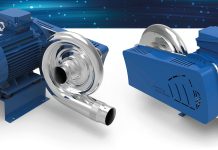Results
Profile of the bottle neck The results of the measurements of the internal diameter of the bottle neck taken along the welding of the glass and perpendicularly to it up to 50 mm depth from the mouth are given in figures 1 and 2. As inferred from the profile curves obtained, the bottles used in the tests show a good regularity of their internal diameters, the values at the level of the mouth are never over the limit of tolerance of 17.5 + 0.4 mm for the Italia neck; the flaring is progressive and finishes at about 30 mm depth, the diameters are constant and, at 45 mm from the level of the mouth, they are never over the maximum value for said neck corresponding to 19 + 1 mm. The flaring of the neck was calculated from the data taken at 45 mm depth and those measured at the level of the mouth. Besides, the possible presence of deformation of the diameters was also examined by comparing said value with the flaring calculated at 40 mm depth (table 1): it results that the bottles do not show any deformation of their internal profile. The other measurements performed on the bottles are given in table 2 for test A (filling level at 70 mm from the mouth) and in table 3 for test B (filling level at 60 mm from the level of the mouth).
Thermal Dilatation – Test A
The experimental test of thermal dilatation of the wine has provided for the samples to stay in thermostats at different temperatures: 40°C, 50°C and 60°C for a time from 3 to 8 hours. As previously told, in this test both bottles have been kept standing. The measurement of the level of the wine has been performed at the end of every phase. The situation at the temperature of 20°C, i.e. at Ti, is given in picture 3. At the end of the period of storage of the samples at 40°C, the level reached by the wine (figure 4) has been measured. At the temperature of 40°C a remarkable rise of the level of the wine in the bottle neck has been noticed, with the consequent reduction of the headspace, which passed from about 24 mm height, measured at 20°C, to about 13 mm measured after the storage at 40°C. At this temperature the samples, if maintained standing, do not show any problem of loss of product. To observe the phenomenon of the capillary rise and coming out of the wine at the level of the mouth, it is necessary to lead the thermal increase up to 60°C (figure 5). When the samples remain some hours at the temperature of 60° C a small loss of product is noticed, but is the storage lasts longer, up to 8 hours, a more important seeping of wine is generated with self-ejection of the cork as shown in figure 6.
Test B
Experimental test B has consisted in filling the bottles at a level of about 60 mm form the mouth, i.e. at a value not corresponding to the one indicated on the bottom of the container. The samples were put in a thermostat at temperatures of 40°C and 50°C for a period of time ranging from 3 to 8 hours. As explained above, during the storage bottle no.1 was standing, while bottle no. 2 was lying. At the end of every phase the level of the wine was measured with precision. The situation at the temperature of 20°C, i.e. at Ti, is shown in figure 7. At the temperature of 40°C the wine touches the cork in the vertical bottle, while the horizontal one starts showing a loss of product (figure 8). It is evident that at 40°C transudation occurs if the bottle is kept lying. This phenomenon causes a loss of wine that starts coming out from the mouth. In the bottle stored lying, the level of the wine measured at 40°C corresponds to 51.82 mm with a difference of – 4.42 mm in comparison to the upright bottle. That difference represents the ullage that, keeping into account the diameter of bottle 2 (table 3), can be evaluated about 1.5 mL. The samples have been put in a thermostat at 50°C again and left there for the 3 following hours. The phenomena observed are (standing and lying bottle) a more important seeping with loss of product was observed in the case of the bottle kept in horizontal position. The values of the level the wine reached after the heating at 50°C and the following cooling to 20°C are given in table 4. The same table shows also the volume of wine evacuated from the bottles after 3 hours at 50°C.
Conclusions
The above description shows that the storage of wine at 40°C and 50°C, i.e. with a temperature change by +20°C and +30°C respectively with respect to the filling temperature caused:
- Capillary rise of the liquid between the glass and the cork already at 40°C with loss of product in the lying bottles, if he filling level indicated on their bottom is not observed – Seeping and wine coming out at 60°C in all situations examined, often with self-ejection of the cork.
- Loss of product generally higher in the bottles kept lying.
From the observations made according to experimental tests we can state that in the Bordeaux bottles with “Italia neck”, a filling level at about 60 mm from the mouth involves the formation of an empty volume between the wine and the cork insufficient to contain the expansion of liquid in case the bottles are stored at temperatures near o higher than 40°C. The observance of the suitable filling level at the temperature of 20°C, as indicated on the bottom of the bottles and corresponding to 70 mm, brings with it the seeping of a part of the wine that, in our tests, was observed starting from the temperature of 50°C. At that temperature the loss of product is evident only in the bottle kept in horizontal position, while in the standing bottle the wine does not reach the base of the cork yet. In the case of the bottle kept standing, the liquid starts the capillary rise and comes out from the mouth only after staying some hours at the temperature of 60°C. Therefore, it can be demonstrated that, assuming the profile of the neck is quite regular and its flaring is correct, the phenomenon of wine seeping and coming out from the mouth is directly connected to the increase in the temperature of the product during storage. The observation of the filling level determined at 20°C, for every type of bottles, allows p ostponing the emergence of said phenomenon at temperatures that would be very high for wine storage and therefore most unlikely to be reached.




